Senior Fitness
By Jim Riley
What if I told you there was an exercise that would improve posture; strengthen your hips, low back and shoulders; and would help balance and improve torso stabilization. Would you do it?
Suppose you only needed to perform this exercise three times weekly for 10 to 15 minutes. Would you do it? What if you could easily work this exercise into your life as you go about your daily activities. Would you do it?
There is such an exercise, and it isn’t often seen being performed in many gyms despite the fact it will improve your work capacity and physical performance.
The exercise is called “the carry,” and it’s probably the oldest exercise known to man. Since earliest times and throughout most of our history until recently, people have had to pick stuff up and carry it to another location many times during the day. It was called work.
Little did these people know that by lifting stuff and moving with it they were building strong, well-aligned bodies that had good balance and work capacity. They were just doing natural hard work to survive.
There are two ways we can improve our bodies with carries. One way is the formal strength training method of loaded or weighted carries in a training session. The second type of carry is about intentionally performing carries as we move throughout the day doing normal activities. Both types of carries will do wonders to improve your fitness base.
The formal method of loaded carries for training is rather simple. The are two basic types of loaded carries, the suitcase carry and the farmers carry.
For the suitcase carry, you pick up the weight with one hand (like a suitcase) and walk with it until moderate fatigue sets in. Then you change hands and walk back to the starting point. Pick a weight you can walk 30 yards with. Over time increase the distance to 50 yards and then enlist a slightly heavier weight.
For the farmer’s carry, pick up an equal weight in each hand that you can walk 30 yards with and, as with the suitcase carry, stretch the distance to 50 yards as you improve and then add weight and recycle.
It sounds simple. What muscles do you strengthen? Almost all of them. The cues for technique needed to execute an effective carry include:
- Pick a weight that you can carry for 30 yards with integrity.
- Align and stand tall with stacked torso.
- Maintain postural integrity as you walk.
With a little thought, informal loaded carries can easily be worked into your daily routines. Walking with any weighted objects constitutes a carry. Laundry baskets full of clothes carried from the laundry room to the bedroom are a carry. Substantial grocery bags carried from the car to the kitchen or from the store to the car is great exercise.
Carry water to hand-water your plants. You not only get exercise, you may save water. Push a full wheelbarrow when gardening. It’s unstable because it has only one wheel and will challenge you more.
Just be creative and make excuses to pick stuff up and walk with it during the day, and you will gain extra fitness benefits.
A primary reason our fitness levels have declined over several generations is that our work does not involve picking up stuff and moving it. There are fewer chores to do and we sit too much.
Performing formal and informal carries builds postural integrity, strength, improves balance and provides us with a basic skill level that will improve our physical performance.
Loaded carries could be called “the quickie head-to-toe workout,” and they are the most natural way to building a foundation for fitness and athletic performance.





